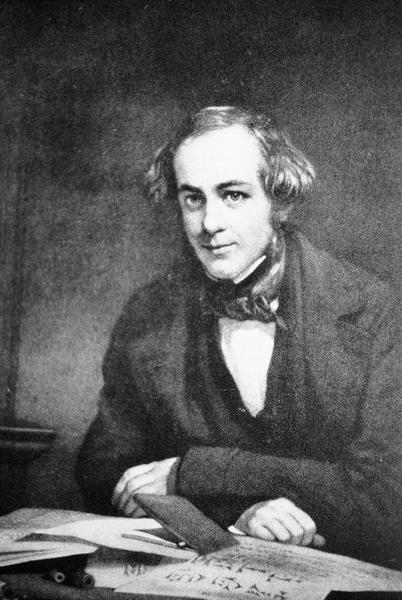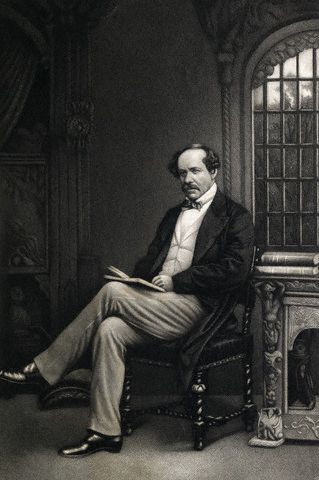<Back to Index>
- Orientalist Henry Creswicke Rawlinson, 1810
- Composer Bonifacio Domenico Pasquale Anfossi, 1727
- Prime Minister of the Netherlands Barend Willem Biesheuvel, 1920
PAGE SPONSOR


Maj.-Gen. Sir Henry Creswicke Rawlinson, 1st Baronet CB (5 April 1810 – 5 March 1895) was a British politician and Orientalist, sometimes described as the Father of Assyriology.
He was born at Chadlington, Oxfordshire, the second son of Abram Tyack Rawlinson, and elder brother of the historian, George Rawlinson.
In 1827 he went to India as a cadet under the British East India Company. After six years with his regiment as subaltern, during which time he had become proficient in the Persian language, he was sent to Persia in company with other British officers to drill and reorganize the Shah's troops. It was at this time that he was first attracted to the study of inscriptions, more particularly those in the hitherto undeciphered cuneiform character. In the course of the two years during which he was in its immediate neighbourhood he transcribed as much as he was able of the great cuneiform inscription at Behistun. This trilingual inscription dated to the 5th century B.C. and the Medes and Persian ruler Darius the Great. Friction between the Persian court and the British government ended in the departure of the British officers.
Rawlinson was appointed political agent at Kandahar in 1840. In that capacity he served for three years, his political labours being as meritorious as was his gallantry during various engagements in the course of the Afghan War; for these he was rewarded by the distinction of Companion of the Order of the Bath in 1844.
Serendipitously, he became known personally to the governor general, which resulted in his appointment as political agent in Ottoman Arabia. Thus he settled in Baghdad, where he devoted himself to cuneiform studies. He was now able, with considerable difficulty and at no small personal risk, to make a complete transcript of the Behistun inscription, which he was also successful in deciphering and interpreting. Having collected a large amount of invaluable information on this and kindred topics, in addition to much geographical knowledge gained in the prosecution of various explorations (including visits with Sir Austen Henry Layard to the ruins of Nineveh), he returned to England on leave of absence in 1849.
He was elected a Fellow of the Royal Society in February 1850 on account of being "The Discoverer of the key to the Ancient Persian, Babylonian, and Assyrian Inscriptions in the Cuneiform character. The Author of various papers on the philology, antiquities, and Geography of Mesopotamia and Central Asia. Eminent as a Scholar".
Rawlinson remained at home for two years, published in 1851 his memoir on the Behistun inscription, and was promoted to the rank of lieutenant - colonel. He disposed of his valuable collection of Babylonian, Sabaean, and Sassanian antiquities to the trustees of the British Museum, who also made him a considerable grant to enable him to carry on the Assyrian and Babylonian excavations initiated by Layard. During 1851 he returned to Baghdad. The excavations were performed by his direction with valuable results, among the most important being the discovery of material that contributed greatly to the final decipherment and interpretation of the cuneiform character. Rawlinson greatest contribution to the deciphering of the cuneiform scripts was the discovery that individual signs had multiple readings depending on their context.
An equestrian accident in 1855 hastened his determination to return to England, and in that year he resigned his post in the East India Company. On his return to England the distinction of K.C.B. was conferred upon him, and he was appointed a crown director of the East India Company.
The remaining forty years of his life were full of activity — political, diplomatic, and scientific — and were mainly spent in London. During 1858 he was appointed a member of the first India Council,
but resigned during 1859 on being sent to Persia as envoy extraordinary
and minister plenipotentiary. The latter post he held only for a year,
owing to his dissatisfaction with circumstances concerning his official
position there. Previously he had sat in Parliament as Member of Parliament (MP) for Reigate from February to September 1858; he was again MP for Frome,
from 1865 to 1868. He was appointed to the Council of India again in
1868, and continued to serve upon it until his death. He was a strong
advocate of the forward policy in Afghanistan, and counselled the retention of Kandahar. Rawlinson was one of the most
important figures arguing that Britain must check Russian ambitions in
South Asia. He argued that Tsarist Russia would attack and absorb Khokand, Bokhara and Khiva (which they did) and would invade Persia (present day Iran) and Afghanistan as springboards to British India. His views were more particularly expressed in England and Russia in the East (1875). He was a trustee of the British Museum from 1876 till his death. He was created G.C.B. in 1889, and a Baronet in 1891; was president of the Royal Geographical Society from 1874 to 1875, and of the Asiatic Society from 1878 to 1881; and received honorary degrees at Oxford, Cambridge, and Edinburgh. He married Louisa Caroline Harcourt Seymour on 2 September 1862, with whom he had two sons: Henry and Alfred. He was widowed on 31 October 1889 and died in London six years later.
His
published works include (apart from minor contributions to the
publications of learned societies) four volumes of cuneiform
inscriptions, published under his direction between 1870 and 1884 by
the trustees of the British Museum; The Persian Cuneiform Inscription at Behistun (1846 – 51) and Outline of the History of Assyria (1852), both reprinted from the Asiatic Society's journals; A Commentary on the Cuneiform Inscriptions of Babylon and Assyria (1850); Notes on the Early History of Babylonia (1854); England and Russia in the East (1875). He contributed articles on Baghdad, the Euphrates and Kurdistan to the ninth edition of the Encyclopædia Britannica, together with several other articles dealing with the East; and he assisted in editing a translation of The Histories of Herodotus by his brother, Canon George Rawlinson.